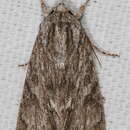Conservation Status
tarjonnut University of Alberta Museums
Rare in Alberta (one record as of 2002), at the extreme northwestern limit of it's range.
- lisenssi
- cc-by-nc
- tekijänoikeus
- University of Alberta Museums
Cyclicity
tarjonnut University of Alberta Museums
The only Alberta record is for an adult collected May 19, 2000.
- lisenssi
- cc-by-nc
- tekijänoikeus
- University of Alberta Museums
Distribution
tarjonnut University of Alberta Museums
Across southern Canada, from Nova Scotia west to eastern Alberta, south to Florida and Texas and in the Rocky Mountains. In Alberta known only from wooded riparian habitat along the arid lower South Saskatchewan River valley, near the Saskatchewan border.
- lisenssi
- cc-by-nc
- tekijänoikeus
- University of Alberta Museums
General Description
tarjonnut University of Alberta Museums
A medium size (3.2 - 4.4 cm wingspan) narrow-winged mottled grey moth with poorly defined markings. There are dark grey or dull black markings in the anal angle, at the reniform and along the costa. There may also be a thin, indistinct black basal streak. The area between the reniform and orbicular spots is lighter than the rest of the wing, as is the very jagged, doubled poorly defined postmedian line. The terminal line is a series or dark dots between the veins; the fringe is checkered grey and white. The hingwing in males is shining white, with a series of dark dots marking the terminal line. The Long-winged Dagger Moth is very similar to the Smeared Dagger Moth, but is slightly darker grey and blotchier in pattern, and has thin black streaks on the wing base and in the anal angle. The antennae are simple. The sexes are similar, but females have darker hindwings.
- lisenssi
- cc-by-nc
- tekijänoikeus
- University of Alberta Museums
Habitat
tarjonnut University of Alberta Museums
Deciduous woodland and shrub.
- lisenssi
- cc-by-nc
- tekijänoikeus
- University of Alberta Museums
Life Cycle
tarjonnut University of Alberta Museums
The larvae are solitary defoliators of deciduous trees and shrubs (Prentice 1962). There is probably a single annual brood in Alberta. The larvae are illustrated in color in Wagner et al (1997). The cocoons are formed between leaves drawn together with silk, and they overwinter as pupae. The adults come to light.
- lisenssi
- cc-by-nc
- tekijänoikeus
- University of Alberta Museums
Trophic Strategy
tarjonnut University of Alberta Museums
No Alberta data; elsewhere reported larval hosts include a variety of deciduous trees and shrubs, including birch (Betula), willow (Salix), cherry (Prunus), oak (Quercus), rose (Rosa), alder (Alnus), and others. (Rings et al. 1992).
- lisenssi
- cc-by-nc
- tekijänoikeus
- University of Alberta Museums

